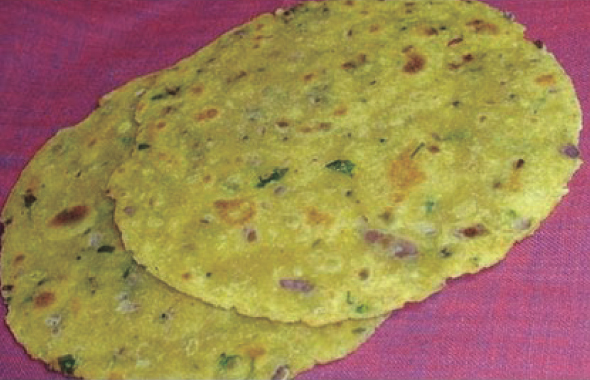Mama’s Punjabi Recipes – Daal Di Roti (Daal Dough Flat Bread)
When it comes to roti – the staple diet of most Punjabis and people of Northwest India – there are several varieties of flours to suit the seasons, like bajra or pearl millet during the winter months and eaten in the arid areas; makkayi or corn for the autumn harvest or kanak (wheat flour), which is the staple and eaten all year round.
And rotis come in many shapes too – square, triangular but most usually round; some large in size and some small, but for Punjabis, a 6 or 8 inch round roti is considered typical. For some villagers, some budget restaurants and dhabas (roadside eateries) and those on a diet, thin dry rotis are common, but most Punjabis enjoy their rotis plump and “chopard” or glaze the crispy side with ghee (clarified butter) or for more modern households, with a little dab of olive oil. The ghee really makes a difference, but it is also fattening.
Very often, there are leftover daal (lentils) and one wonders what to do with them, especially if no one wants to eat it anymore. Leftover daals with the curry sauce are excellent for a tastier version of roti, which can be eaten with yogurt or with any other dish. Most people like these rotis and the leftovers are gone too!
When making the dough, the daal curry takes the place of the water that is used in kneading the flour. Since the flour is mixed with the daal, it is less sticky so it is important to remember to use smaller amounts of dough and roll them into smaller rounds than with normal dough.
Ingredients:
500gm kanak (gehon) ka atta (wheat flour)
Leftover daal (lentil curry)
Some ghee (clarified butter) or tael (olive oil or vegetable oil) for greasing
Spices to taste: namak (salt), mirch (red pepper)
Directions:
1. Pour the flour in a bowl and slowly pour the daal curry in while kneading the dough till it becomes a nice, tender by firm ball. Use as much flour as the available sauce can handle. Make sure the daal is well mixed with the flour, but the daal grain does not need to be mashed into it. If the dough is too hard, the roti will also be hard. Add extra spices only if desired as the daal usually has plenty to begin with.
2. Dab the surface of the ball with a little water to keep it moist, cover the bowl and set aside for 30 minutes.
3. Grease your palms then pinch off a portion of the dough and make into a 2 inch payda (round ball).
4. Pour a little dry flour on the counter and roll the ball in it to coat it. Now use a velna (rolling pin) to roll the ball into a nice round, flat pancake, about 1/8 inch thick. Do not roll out too much – just 5 to 6 inches is enough – otherwise the roti will start to fall apart.
5. Place the tava (flat skillet) on the stove and heat on medium. Now carefully place the flattened dough on the tava. Once the dough starts to show some bubbles, then turn it over. Let the other side also cook till bubbles appear. Now flip the dough again and when you see small brown spots, gently press the top with a clean, soft cloth. The roti will not rise and fluff up but the sides will get crispy.
6. Take the roti off the tava and keep on the side. If it is overcooked it will show large dark spots. Cover with a clean soft cloth to keep warm; do not place in a plate right away as the roti will shed some water vapor.
7. Now repeat the process till the rest of the daal rotis are made and the dough is finished.
******
MAMA’S TIP OF THE WEEK
KEEPING LEFTOVERS FRESH LONGER
In these days of refrigerators, one tried and true method still works for leftovers. If the food has been refrigerated for two or three days, simply take it out and place it in a skillet or saucepan and then heat it over medium to high heat for a few minutes. This keeps any bacteria from forming and the food can be kept for another day.
******
Shakuntla Malhotra is a skilled cook of Punjabi dishes made in the old-fashioned style that she learnt as a young woman in her ancestral home in Lyallpur, India before it became part of Pakistan after the Partition in 1947. People have often admired her cooking for its simplicity and taste that comes with each mouthful. Even in her mid-eighties, she continues to cook daily and agreed to share some of her delectable Punjabi recipes.


